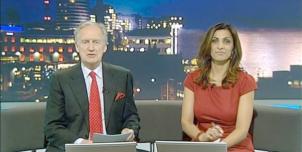Full Freeview on the Sutton Coldfield (Birmingham, England) transmitter
| Google Streetview | Google map | Bing map | Google Earth | 52.600,-1.835 or 52°36'1"N 1°50'5"W | B75 5JJ |
The symbol shows the location of the Sutton Coldfield (Birmingham, England) transmitter which serves 1,870,000 homes. The bright green areas shown where the signal from this transmitter is strong, dark green areas are poorer signals. Those parts shown in yellow may have interference on the same frequency from other masts.
This transmitter has no current reported problems
The BBC and Digital UK report there are no faults or engineering work on the Sutton Coldfield (Birmingham, England) transmitter._______
Digital television services are broadcast on a multiplexes (or Mux) where many stations occupy a single broadcast frequency, as shown below.
64QAM 8K 3/4 27.1Mb/s DVB-T MPEG2
DTG-12 QSPK 8K 3/4 8.0Mb/s DVB-T MPEG2
H/V: aerial position (horizontal or vertical)
Which Freeview channels does the Sutton Coldfield transmitter broadcast?
If you have any kind of Freeview fault, follow this Freeview reset procedure first.Digital television services are broadcast on a multiplexes (or Mux) where many stations occupy a single broadcast frequency, as shown below.
64QAM 8K 3/4 27.1Mb/s DVB-T MPEG2
DTG-12 QSPK 8K 3/4 8.0Mb/s DVB-T MPEG2
H/V: aerial position (horizontal or vertical)
Which BBC and ITV regional news can I watch from the Sutton Coldfield transmitter?

BBC Midlands Today 2.9m homes 10.9%
from Birmingham B1 1RF, 15km south-southwest (200°)
to BBC West Midlands region - 66 masts.

ITV Central News 2.9m homes 10.9%
from Birmingham B1 2JT, 15km south-southwest (201°)
to ITV Central (West) region - 65 masts.
All of lunch, weekend and 80% evening news is shared with Central (East)
Are there any self-help relays?
| Burton (shobnall) | Transposer | 1 km W Burton-on-Trent | 60 homes |
| Coalville | Transposer | 18 km NW Leicester | 600 homes |
| Solihull | Transposer | Land Rover building | 400 homes |
How will the Sutton Coldfield (Birmingham, England) transmission frequencies change over time?
| 1950s-80s | 1984-97 | 1997-98 | 1998-2011 | 2011-13 | 7 Mar 2018 | ||||
| VHF | B E T | B E T | B E T | B E K T | W T | ||||
| C4 | BBCtvwaves | ||||||||
| C33 | com7 | ||||||||
| C35 | com8 | ||||||||
| C36 | LOCAL2 | ||||||||
| C39 | +ArqB | ArqB | |||||||
| C40 | BBC2waves | BBC2waves | BBC2waves | +BBCB | BBCB | ||||
| C42 | SDN | SDN | |||||||
| C43 | ITVwaves | ITVwaves | ITVwaves | BBCA | BBCA | ||||
| C45 | ArqA | ArqA | |||||||
| C46 | BBC1waves | BBC1waves | BBC1waves | D3+4 | D3+4 | ||||
| C48 | _local | ||||||||
| C50tv_off | C4waves | C4waves | C4waves | ||||||
| C51tv_off | LB | ||||||||
| C55tv_off | com7tv_off | ||||||||
| C56tv_off | COM8tv_off |
tv_off Being removed from Freeview (for 5G use) after November 2020 / June 2022 - more
Table shows multiplexes names see this article;
green background for transmission frequencies
Notes: + and - denote 166kHz offset; aerial group are shown as A B C/D E K W T
waves denotes analogue; digital switchover was 7 Sep 11 and 21 Sep 11.
How do the old analogue and currrent digital signal levels compare?
| Analogue 1-4 | 1000kW | |
| SDN, ARQA, ARQB, BBCA, D3+4, BBCB | (-7dB) 200kW | |
| com7 | (-10.5dB) 89.2kW | |
| com8 | (-10.7dB) 86kW | |
| LB | (-20dB) 10kW | |
| Mux 1*, Mux 2*, Mux A*, Mux B*, Mux C*, Mux D* | (-21dB) 8kW |
Which companies have run the Channel 3 services in the Sutton Coldfield transmitter area
|
|
Wednesday, 9 November 2011
B
Brian Springthorpe6:23 PM
I am currently undertaking to do a house clearance at my mum's house in Wolverhampton.
I am having to say over for a few days at a time so I need a telly!
I bought a cheap as chips Freeview set top box from Tesco and away we went.
When I switched off, and switched on again the next night, it was as if the damn thing had never been tuned in. I had to retune. Then the signal kept dropping out and the message on the screen informed me that the aerial wasn't connected.
I got the box bacl home to North Wales and it works just fine.
So what's going on?
| link to this comment |
Brian Springthorpe: I would guess it is Freeview signals: too much of a good thing is bad for you | ukfree.tv - independent free digital TV advice given the strength of TV signals in Wolverhampton.
| link to this comment |
Thursday, 10 November 2011
Freddie: If you could actually read Freeview signals: too much of a good thing is bad for you | ukfree.tv - independent free digital TV advice ?
| link to this comment |
Friday, 11 November 2011
J
jb387:49 AM
Freddie: Plus to what you will read on Briantist's link, you should be aware that the indications seen on most TV's when receiving a signal on the verges of being over powerful are liable to be totally inaccurate, as they are only a reference guide for that particular set and not by any means what you would obtain from a test instrument.
The aspect that misleads most people being, that the symptoms experienced in areas with exceptionally high signal strengths are "exactly" the same as when in the reverse of the situation, and the only way for any person to prove categorically if this is their problem (or not!) is to purchase (or borrow) a variable attenuator, as if this is inserted in line with the aerial socket of the TV and the signal strength observed with it set to its zero reduction position, then if when slowly advancing the adjuster the signal strength is actually seen rising rather than falling then that's the proof of an "over the top" signal being received, and something which causes instability in most equipments tuners hence the type of problems you mention.
| link to this comment |
Freddie: I would also advise against writing to your MP to complain, as they are unable to do anything about the laws of physics, in this case the inverse power law - Power law - Wikipedia, the free encyclopedia .
| link to this comment |
B
Brian Springthorpe8:57 AM
Briantitst,
Given that the signal in Wolverhampton is too strong, I have got a couple of adjustable attenuators that I thought I might need for North Wales where I live, (but didn't!). These are adjustable between 0 to 20dB or so it says on the device.
I also have a simple signal finder. I am assuming that the aerial is pointing the right direction, as I don't really want to climb on the roof at my age, so when I hook up my finder what optimal signal strength should I be looking for?
By the way, when I abandoned using the TV and decided to use my computer to pick up the TV I had no problems whatsoever!
| link to this comment |
Brian Springthorpe: What units is your "simple signal finder" calibrated in? From memory the minimum signal level is -80dBm.
As a general rule, the external USB DVB-T receivers usually perform very well. This could be due to being distant from the electrical noise of the inside of a television set or set top box.
| link to this comment |
Saturday, 12 November 2011
B
Brian Springthorpe9:06 AM
Briantist,
It's just a simple cheap SLX DB-T Signal Meter.
It has 4 green lights marked as 80, 70, 60, and 50 dBv.
So if the signal is more than 80 I am going to be unsure I think.
| link to this comment |
Tuesday, 15 November 2011
J
John O'Connor11:58 PM
So - here we go again... I can only presume the intermittent problems we have been having here (WR14 in Malvern) with Freeview is due to the engineering work; but it would be really useful to have advanced warning. Is this ever likely to be the case? That way I could have used my time this evening more productively. I can't believe there isn't some way of using a teeny bit of the bandwidth to alert users to the potential of singal breakup or loss.
Does anybody have any experience of a successful communication with Arqiva on the issues of transmitter work forecasts and updates? It looks from their websites as if they don't want to be bothered by the public, and I get the impression so far that the attitude is 'it's free - so what have you got to complain about?'
Don't ask.
John
| link to this comment |
Select more comments
Your comment please!





